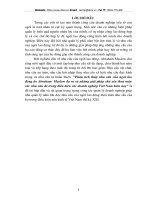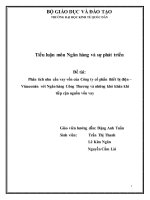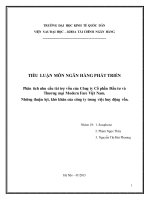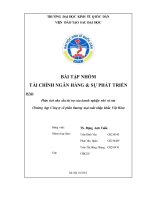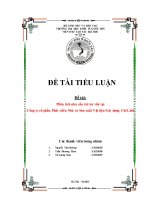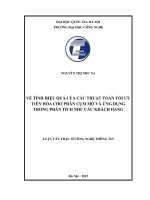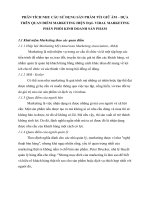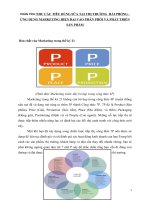Designing an ESP course needs analysis and english language proficiency of BIDV bankers = thiết kế khoá học tiếng anh chuyên ngành dựa trên phân tích nhu cầu và trình độ ngôn ngữ của nhân viên ngân hàng BIDV
Bạn đang xem bản rút gọn của tài liệu. Xem và tải ngay bản đầy đủ của tài liệu tại đây (2.4 MB, 126 trang )
VIETNAM NATIONAL UNIVERSITY, HANOI
UNIVERSITY OF LANGUAGES AND INTERNATIONAL STUDIES
FACULTY OF ENGLISH LANGUAGE TEACHER EDUCATION
GRADUATION PAPER
Designing an ESP Course: Needs analysis and English
language proficiency of BIDV bankers
Supervisor: Cấn Thị Chang Duyên M.A.
Student:
Tạ Phương Thảo
Course:
QH2017.F1.E2
Hà Nội, 2021
ĐẠI HỌC QUỐC GIA HÀ NỘI
TRƯỜNG ĐẠI HỌC NGOẠI NGỮ
KHOA SƯ PHẠM TIẾNG ANH
KHOÁ LUẬN TỐT NGHIỆP
THIẾT KẾ KHOÁ HỌC TIẾNG ANH
CHUN NGÀNH DỰA TRÊN PHÂN TÍCH
NHU CẦU VÀ TRÌNH ĐỘ NGÔN NGỮ CỦA
NHÂN VIÊN NGÂN HÀNG BIDV
Giáo viên hướng dẫn: Cấn Thị Chang Duyên M.A.
Sinh viên:
Tạ Phương Thảo
Khoá:
QH2017.F1.E2
Hà Nội, 2021
TABLE OF CONTENTS
ACKNOWLEDGEMENT ...................................................................................... i
ABSTRACT........................................................................................................... ii
LIST OF FIGURES AND TABLES .................................................................... iii
CHAPTER I: INTRODUCTION........................................................................... 1
1.
Rationale of the study ................................................................................. 1
2.
Research aims and research questions ........................................................ 2
3.
Significance of the study............................................................................. 3
4.
Scope of the study ....................................................................................... 3
5.
Organization of the study ............................................................................ 4
CHAPTER 2: LITERATURE REVIEW ............................................................... 5
1.
Overview of ESP ........................................................................................ 5
2.
ESP course design ....................................................................................... 6
3.
4.
2.1.
Definition of an ESP course design ..................................................... 6
2.2.
Characteristics of an ESP course ......................................................... 7
2.3.
Course design .................................................................................... 10
2.5.
ESP Course design frameworks ........................................................ 12
Needs analysis........................................................................................... 13
3.1.
Definition of needs analysis .............................................................. 13
3.2.
Needs analysis framework................................................................. 14
English language proficiency.................................................................... 16
4.1.
English language proficiency ............................................................ 16
4.2.
Testing in ESP ................................................................................... 17
5.
Review of previous studies ....................................................................... 18
6.
Summary of the chapter ............................................................................ 19
CHAPTER III: RESEARCH METHODOLOGY ............................................... 21
1.
Setting and participants ............................................................................. 21
2.
3.
1.1.
Setting ................................................................................................ 21
1.2.
Participants ........................................................................................ 21
Data collection instrument ........................................................................ 22
2.1.
Semi – structured questionnaire ........................................................ 22
2.2.
Language Proficiency Test ................................................................ 25
Data collection & data analysis procedure ............................................... 29
CHAPTER IV: FINDINGS AND DISCUSSION ............................................... 31
1.
General information .................................................................................. 31
2.
Research question 1: The English proficiency of BIDV employees ........ 33
3.
Research question 2: Needed skills and English related tasks.................. 38
4.
Research question 3: The preferred modes of teaching – learning ........... 43
Summary of the chapter ................................................................................... 45
CHAPTER V: CONCLUSIONS ......................................................................... 47
1.
Summary of the findings........................................................................... 47
2.
Recommendations and Implications ......................................................... 48
3.
Limitations ................................................................................................ 49
4.
Suggestions for further studies ................................................................. 50
REFERENCES .................................................................................................... 51
APPENDICES ..................................................................................................... 56
APPENDIX 1: A CHECKLIST FOR MATERIALS EVALUATION ........... 56
(HUTCHINSON & WALTER, 1987, P.99 – 104) .......................................... 56
APPENDIX 2: TARGET SITUATION ANALYSIS FRAMEWORK ........... 61
APPENDIX 5: QUESTIONNAIRE (VIETNAMESE VERSION) ................. 66
APPENDIX 6: TEST ....................................................................................... 74
APPENDIX 7: MATERIAL EVALUATION ................................................. 84
APPENDIX 8: DETAILED SYLLABUS ....................................................... 91
ACCEPTANCE PAGE
I hereby state that I: Ta Phuong Thao, QH2017.F1.E2, being a candidate for the
degree of Bachelor of Arts (TEFL) accept the requirements of the College relating
to the retention and use of Bachelor’s Graduation Paper deposited in the library.
In terms of these conditions, I agree that the origin of my paper deposited in the
library should be accessible for the purposes of study and research, in accordance
with the normal conditions established by the librarian for the care, loan or
reproduction of the paper
Signature
Date: May 3rd, 2021
ACKNOWLEDGEMENT
The success and final outcome of this research required a lot of guidance
and assistance from many people and I are extremely privileged to have got this
all along the completion of my work.
First and foremost, I wish to extend the deepest appreciation and respect to
my supervisor Ms. Can Thi Chang Duyen for her comprehensive insight in the
field of research, patient guidance, devoted assistance as well as constructive
critiques of this research work. I am grateful for your relentless and enthusiastic
support, without which I would not have been able to complete my thesis.
In addition, I would want to express my heart-felt thanks to all the
employees of BIDV for their cooperation and support in completing the
questionnaires. Furthermore, our grateful thanks are also extended to BIDV’s
human resource manager, who was willing to give her time so generously to
support me with the internal documents.
My gratitude goes to all my dear friends, especially Pham Huyen Trang, Vo
Thi Trang and Do Quynh Trang who were always there to give me the support I
need. I can never disregard significant support from my beloved family as well,
and especially my father, who patiently waited for me in days I come home late.
Lastly, I wish to thank my boyfriend for his compassion, patience and unfailing
support even when I lose my temper during sleepless nights. His positivity and
magnanimity have motivated me to overcome all the obstacles along the way.
ABSTRACT
In the age of globalization, the number of foreign enterprises investing in
Vietnam is growing at an unprecedented speed. Among all banks, BIDV - bank
for Investment and Development of Vietnam is the most established commercial
bank and therefore, should welcome these new waves of investments in front. To
accomplish their mission, the bank’s personnel need be proficient in English to
facilitate their working procedure with foreign business partners. However,
general English has proven to be not sufficient for bankers to perform job-related
communicative functions at a satisfactory level (Wu & Chin, 2017). In response
to the urgent demand on how to enhance the language proficiency of BIDV
employees, this study aims to build an ESP course on Banking and Finance based
on learners’ needs and English proficiency. The researcher adopted quantitative
method to analyse the needs of 20 participants from 3 departments where English
is most needed. Afterwards, a level-based assessment test is designed and
conducted to select participants most suitable for the course. According to the
aggregation of the need analysis and the assessment result, speaking and writing
– related tasks are more imperative than tasks requiring productive skills. With
regards to the learning – teaching techniques, learners tend to prefer
communicative languague teaching (CLT) method as well as pair or group work.
Considering participants’ English proficiency, almost three forth of the employees
are under B1 level (CEFR) and need to take the course. Finally, an ESP course on
Banking and Finance is designed, implication for pedagogic application and
foundations for further researches are discussed.
Keywords: ESP course design, banking and finance, need analysis, language
proficiency assessment
LIST OF FIGURES AND TABLES
Figure 1. Factors affecting ESP course design
Figure 2. Needs analysis
Figure 3. distribution of participants from BIDV department
Figure 4. level of lexical resource in vocabulary section (placement test)
Figure 5. level of lexical resource in grammar & structure section (placement
test)
Figure 6. level of lexical resource in reading section (placement test)
Figure 7. General information of the participants
Figure 8. participants’ preference in class schedule
Figure 9. Participants test score
Figure 10. English level of participants (compared to B1 CEFR)
Figure 11. Self-assessment of English proficiency
Figure 12. Self assessment of receptive tasks
Figure 13. Self assessment of productive tasks
Figure 14. English skills needed for work
Figure 15. The level of need of listening and reading – involved tasks
Figure 16. The level of need of speaking and writing – involved tasks
Figure 17. learners’ preferable modes of learning – teaching
CHAPTER I: INTRODUCTION
1.
Rationale of the study
English language plays a crucial role in daily lives and in business contexts
of the 21st century. Widely used in more than 60 countries, the English language
is an international language with respect to different aspects of communication:
sharing information, communicating through commercial activities, and travelling
worldwide for different reasons (Karimi & Vahdani Sanavi, 2014). In this era of
globalization, regarding the sections of banking, finance and economy, being able
to use English for communication is becoming increasingly critical. More than a
century ago, English was needed for national survival; today it is needed for
economic survival (Sukwiwat, 1985). This highlights the idea that English can
facilitate the process of economic development.
In the context of Vietnam, EVFTA (EU – Vietnam Free Trade Agreement)
was officially implemented in August, 2020, allowing foreign products and
investments into Vietnam without being taxed (2020). Apart from that, CPTPP
(Comprehensive and Progressive Agreement for Trans – Pacific Partnership)
came into force in 2018, marking the world third largest free trade market.
Furthermore, a new wave of investment from European countries, America, Japan,
and Korea, is hitting Vietnam after the Covid-19 pandemic. The English
Proficiency Index (EPI) by the international organization Education First (2020)
suggests that English and Korean in business contexts are also experiencing an
upward trend. In order to embrace these golden chances of economic growth,
banking and finance professionals need to have a good command of the English
language to communicate and negotiate in business procedures effectively.
BIDV – Bank for Investment and Development of Vietnam is the most
established commercial bank in Vietnam in 2016 and the fourth largest enterprise
of Vietnam according to the annual report of UNDP in 2017. Among all banks,
BIDV is one critical body contributing to Vietnam’s overall financial well-being
and economic development as this bank provides financial assistance and
consultance to most foreign enterprises and companies investing in Vietnam.
According to Education First’s English Proficiency Index (EPI) in 2012, English
is the key to attracting foreign investments. Sufficient English use can facilitate
the working procedure and bring in greater profits. BIDV, as a national bank for
investment and development, should welcome these new waves of investments in
front. To accomplish their mission, BIDV personnel need to be proficient in
English to facilitate their working procedure with foreign business partners.
However, general English has proven to be insufficient for bankers to
perform job-related communicative functions at a satisfactory level (Wu & Chin,
2017). Consequently, there is a growing need for English for Special Purposes
(ESP), allowing learners to acquire and use language that is closely linked to their
working situations. An ESP course is highly recommended for learners with
specific purposes for studying English as an ESP course needs to be built upon a
need analysis (Barkane, 2017). In other words, an ESP course allows educators to
thoroughly analyse the needs of students, hence, formulate linear course goals/
objectives (Hutchinson & Waters, 1987). Data from a systematic needs analysis
in forming an ESP course can strengthen the demand and supply link to guarantee
what needed is taught to learners, and what taught is used.
Though the importance of need analysis and ESP course in learning English
is widely acknowledged, their application in the context of Vietnam has proven to
be limited. For Vietnamese professionals, English courses in the field of
economics are available. However, little thorough research to design a course on
Banking and finance has been conducted. All these conditions have motivated the
researcher to carry out a study on “Designing an ESP Course based on the needs
and English language proficiency of BIDV bankers”.
2.
Research aims and research questions
This paper aims to analyse the needs of a group of BIDV bankers to discover
the English – related tasks and skills required at their workplace. The research also
focuses on the learners’ difficulties in performing English – related tasks, their
favorable learning – teaching styles, expectations and English language
proficiency. The research will synthesize and analyse the collected data to design
a course with the teaching contents and methods that best fit the targeted group of
learners.
The research is carried out to answer the following questions:
1.
What is the current level of English proficiency among BIDV employees?
2.
What are the English-related tasks and skills that employees need to
perform at work?
3.
What learning modes do they prefer?
3.
Significance of the study
This research contributes to the overall study of need analysis and ESP
course design for learners working in Banking and Finance in general and those
working for BIDV in particular. First, this research will ensure the unification
between what is taught and what is needed, resulting in a more effective and
realistic English course for learners with specific purposes. This paper also serves
as a source of reference for ESP practitioners and learners of Vietnam to conduct
further research into the field.
4.
Scope of the study
The research paper is built upon need analysis and the learners’ language
proficiency, therefore, will lay emphasis on the learners’ necessities (skills and
levels needed to perform English tasks in the target situation), lacks (the mismatch
between the learners’ ability and their target) and wants (the learners’ desirable
teaching-learning modes). The result of this research will lay the foundation for
other researchers to build a comprehensive and suitable course on Banking and
Finance for Bankers.
The research’s participants limit only to 20 employees of BIDV and focus
on English for the field of banking and finance. Though the target subjects are
BIDV employees, the results can still represent Vietnamese banking
professionals.
5. Organization of the study
This thesis comprises five chapters.
Chapter 1: Introduction – reveals the research problem, research aims,
research questions, scope, significance, and the organization of the study.
Chapter 2: Literature Review – reviews relevant literature to this research
work, including the definitions of some terms, followed by a description
and selection, evaluation and analysis of an ESP course. This chapter
discloses the framework of the study.
Chapter 3: Research Methodology – explains the research methods, the
context, and participants of the study, together with the data collection and
data analysis procedure.
Chapter 4: Findings and Discussion – offers the research results and the
discussions about the findings to provide answers to four research
questions.
Chapter 5: Conclusions – summarises the significant findings, provides
the recommendations for students, ESP lecturers, and ESP course designers,
as well as highlights some limitations of the study, and suggests directions
for the future research area.
CHAPTER 2: LITERATURE REVIEW
1. Overview of ESP
English for Specific Purposes (ESP) is defined in various ways by different
linguists. Hutchinson and Waters (1987) defined ESP as an “approach” rather than
a “product”, indicating that ESP does not involve a particular kind of language,
teaching material, or methodology. In their research, ESP revolves around the
question of “Why does this learner need to learn a foreign language?”. The
rationale of learning English is the core of ESP. Further research into the field has
also provided supporting definitions of ESP. Robinson (1980) defined it as
teaching English to learners who have specific goals and purposes. Those purposes
can either be academic, professional, or scientific ones, primarily based upon
learners’ needs. ESP, then, is a broad approach to language teaching in which all
selections of content, teaching-learning method, assessment method are based on
the learner’s reason for learning. In 1988, Strevens defined the term ESP based on
its four absolute and two variable characteristics. His definition was later revised
and adapted by Dudley Evans and St John (1998, p.5) as follows:
Absolute characteristics:
1. ESP is defined to meet the specific needs of the learners
2. ESP makes use of the underlying methodology and activities of the
discipline it serves
3. ESP is centered on the language appropriate to these activities in terms of
grammar, lexis, register, study skills, discourse, and genre.
Variable characteristics include the following:
1. ESP may be related to, or designed for, specific disciplines
2. ESP may use, in specific teaching situations, a different methodology from
that of General English
3. ESP is likely to be designed for adult learners, either at a tertiary level or in
a professional work situation. It could, however, be for learners at the
secondary school level
4. ESP is generally designed for intermediate or advanced students
5. Most ESP courses assume some basic knowledge of the language system
The definition provided by Dudley Evans and St John (1998) removed the
absolute characteristic that “ESP is in contrast with General English” and added
several variable characteristics. This adapted definition will also be employed as
the foundation for this research.
2. ESP course design
2.1.
Definition of an ESP course design
Course design is the process whose ultimate aim is to lead the learners to a
particular state of knowledge by producing an integrated series of teachinglearning experiences through the interpreted data about learning needs
(Hutchinson and Waters, 1987). Course designing is significant to ESP
practitioners and ESP learners as they have very distinct purposes when learning
the language. In designing a course, the personal and professional profile of
learners, their needs and expectations, weaknesses and strengths, etc., will be
considered to serve as the basis for designing syllabus, material, teaching, and
assessment methods.
In designing a course, one must take into account the “input” (topics, skills,
language, linguistic feature, etc.), the “output” of desired students’ performance
(the skills or languages students are expected to perform, at a specific level,). Last,
one should consider the “process” (the map of how to achieve the “output”, in
which learning - teaching activities, material and assessment method are selected)
(Wiggins & McTighe, 2006).
Difference between ESP course design & General English (GE) course
design
The core distinction of ESP and GE lies in the target learners and their
rationale for studying English. Learners following an ESP course often need the
language to perform a particular job-related task. Therefore, ESP focuses more on
the language one needs to use in a real professional context than just grammar
structures or vocabulary unrelated to the professional field. GE, on the other hand,
is taught regardless of the learner’s future situation.
According to Hutchinson and Waters (1987), an ESP course and a GE
course are mostly similar in theory, but very different in terms of practice. At the
time, teachers of GE courses rarely conduct needs analysis despite the fact that
every student learned English for a reason. These days, more GE teachers are
conducting deeper analysis of their students’ needs, with a view of selecting
appropriate teaching contents and materials. This can be the most significant
influence ESP has on GE teaching process.
2.2.
Characteristics of an ESP course
Various researchers have looked into the characteristics of an ESP, and
most of them, including Strevens (1988), Dudley Evans (1997), Robinson (1988),
show agreement with the properties Carter proposed in 1983, in which ESP is
charactised with three major features: authentic material, purpose-related
orientation, and self-direction.
• An ESP course has purpose-related orientation, and learners learn English
because they need or will need English in their professional or academic
lives. Therefore, an ESP course should be based on an analysis of needs, in
which teachers specify what learners need to perform via the medium of
English. In this sense, the first stage in any ESP course is identifying the
learners’ reason to learn English and what tasks that require the use of
English (Robinson, 1988). An ESP learner does not necessarily need a high
level of English proficiency as the end of learning English is only to perform
their task to the required level.
• “Self-direction” means that students learn English to become users (Carter,
1983). ESP learners tend to be adults, have set their goals on a specific
profession (Robinson, 1988). They only study English as a medium to better
perform their task, and therefore, should have the ability and freedom to
decide on when, where and how they will use the language.
• An ESP course requires authentic materials. There may be no fixed syllabus
or materials developed for teaching purposes. The materials should be
retrieved from learners’ target situations, in the form of books, forms,
charts, graphs. These materials can either be modified or unmodified,
depending on the teaching context (Dudly Evans, 1997). An ESP
practitioner would not look at a teaching material and ask, “what can I do
with this?” but rather, “What do my learners need to do? What texts are they
required to read? How can I adopt or adapt these texts to help my students
learn?”
Parameters & factors to be considered when designing an ESP course:
In designing an ESP course, Hutchinson and Water (1987) stated three
distinct factors to be considered in designing an ESP course, including learning
theories, needs analysis and language descriptions. The relationship between these
three factors and an ESP course can be described as follows
Figure 1. Factors affecting ESP course design
Syllabus
ESP course
Methodology
How?
Learning
theory
Nature of particular
target and leanring
situation
What?
Language
description
Who? Why?
Where? When?
Needs analysis
Apart from the factors proposed by Hutchinson and Water in 1987, Dudley
Evans and St John in 1998 (p.81) suggested that several parameters also need to
be taken into account in designing a course:
1. Should the course be intensive or extensive?
2. Should the learner’s performance be assessed or non-assessed?
3. Should the course deal with immediate needs or with delayed needs?
4. Should the role of the teacher be that of the prodder of knowledge and
activities or a facilitator of activities arising from learners’ expressed
wants?
5. Should the course have a broad or narrow focus?
6. Should the course be pre-study or pre-experience or non-parallel with that
study, or experience?
7. Should the material be common-core or specific to learners’ study or work?
8. Should the group taking the course be homogeneous or heterogeneous?
Should the language teacher work out the course design after consultation
with the learners and the institution, or should it be subject to a process of
negotiation with the learners?
2.3.
Course design
2.3.1. Approaches to course design
As written in the “Curriculum approaches in language teaching: Forward,
Central, and Backward design” by Richards (2013), there are three main
approaches to designing a course:
The forward design is based on the assumption that input, process and output are
related in a linear fashion. In this approach, the method of teaching-learning and
the expected outcome is driven by the input (the field of knowledge that is expected
to be taught).
The central design is a ‘learner-focused and learning-oriented perspective’.
A central designed course is more concerned with the methodological procedure.
It lies less emphasis on syllabus specification, which suggests central design is
more concerned with the learning process than the determined objectives.
The backward design takes “output” as its essence and develops the “input” and
“process” accordingly. In backward designing, the needs of learners receive utmost
priorities. The learning-teaching content and the teaching-learning methods,
materials will then be selected to achieve the initially set goals. The assessment is
used to judge whether the ends are met.
Generally, the backward design is most appropriate in design an ESP
course, as learners are particularly goal-oriented. They need what they learn and
should only learn what they need. In following backward design, competencybased instruction is widely used for its similar advantages with backward design.
Wiggins and McTighe (2006) suggested that the process involves:
• Analysing needs to find learning - teaching content
• Identify competency for each topic
• Group competencies into instructional units
• Identify the language and knowledge needed for each instructional unit
• Choose material.
These steps will be adopted to formulate the ESP course on Banking and Finance
for BIDV employees.
2.4.
Scope and sequence of content
It is suggested that the “scope” of a course involves the content of learning
– teaching, specifically the range and extent of such content (Richards, 2021). This
matter will be determined by the needs analysis.
The sequence of content is also crucial in designing a course. Specifically,
Richards (2021) mentioned six sequencing patterns in his research, “Curriculum
development in language teaching”, which are simple to complex, chronology,
needs, prerequisite learning, whole to part-part to whole and spiral sequencing.
Specifically:
• “Simple to complex” sequencing is organizing content based on the level
of difficulty.
• “Chronology” is organizing content according to the order of events in the
real world (listening – speaking, reading – writing)
• “need” is sequencing content according to the imperativeness of tasks
outside the classroom.
• “Prerequisite learning” is the order in which one concept is the foundation
to another, ;therefore, it must be taught first.
• “Whole to part” sequencing will put forward the overall structure before
focusing on the minor elements included, while “part to whole” puts the
more minor elements before the overall structure.
• “Spiral” sequencing is recycling content over and over again until the items
are deeply ingrained in learners’ memory.
2.5.
ESP Course design frameworks
2.5.1. Types of syllabus framework
As suggested in Curriculum development in language teaching (Richards,
2001), a syllabus could be designed following some of the frameworks:
• Grammatical syllabus is organized around grammatical items and is
frequently used in general courses.
• Lexical syllabus: target the amount of vocabulary (500, 1000, 1500) one
acquires, which is considered the determiner of a student’s level.
• Situational syllabus: organized around different situations and the oral
skills needed in those situations (booking a car, writing a letter)
• Topical: organized around different topics and how to talk about them in
English (family, learning, working)
• functional: organized around the functions most commonly needed in
speaking (requesting, asking)
• task-based is organized around different tasks and activities that the learners
would carry out in English such as reading a map or giving direction.
• skill-based syllabus: organized around the abilities one needs to use the
language, including writing (topic sentence, supporting ideas), listening
(keywords, specific information), speaking (introducing, arguing) or
reading (specific information, general ideas)
The framework of designing a syllabus should be selected according to the
needs of learners (in terms of content) and their preferable learning – teaching
method.
2.5.2. Material evaluating framework
The material comes in many forms: text, audio, newsletter, etc., but most
commonly, they are textbooks. Textbooks are critical to the success of a course as
it serves as the basis for language input and constructs the balance of skills taught.
A good textbook provides structure and syllabus for the program, standardizes all
instructions, maintains the quality of lessons, provides valuable resources and can
be visually appealing (Richards, 2001). The process of evaluating textbooks can
be divided into three parts: pre-use, in-use and post-use evaluation. As the research
is developing a course for employees working in Finance and Banking, it will only
be concerned with pre-use evaluation.
A checklist for material evaluation (Hutchinson & Walter, 1987) and a
tentative checklist for textbook evaluation (Mukundan et al., 2001) have been put
forward and adopted in various research. The framework proposed by Hutchinson
and Walter (1987) allows the researcher to look at the material through both
subjective and objective analysis, which the checklist by Mukundan (2001) failed
to offer, guaranteeing the alignment of expectation and reality. Also, the
framework is divided explicitly into five criteria, including the audience, aim,
content, methodology, and other criteria, and this allows the material to be
analyzed comprehensively. For such reasons, the framework by Hutchinson and
Walter (1987) will be adopted to evaluate course books in this paper.
3. Needs analysis
3.1.
Definition of needs analysis
The term “needs analysis” appeared first in the 1920s in India. According
to West (1994), “needs” refers to “What learners will be required to do with the
foreign language in the target situation, and how learners might best master the
target language during the period of training.” “needs analysis”, defined by Brown
(1995), is a “systematic collection and analysis of all subjective and objective
information necessary to define and validate defensible curriculum processes that
satisfy the language learning requirements of students within the context of a
particular institution that influence the learning and teaching situation”. “Needs
analysis”, according to Dudley-Evans and St John (1998), set the foundation for
building a course’s syllabus, material, teaching-learning process and evaluation
methods. Hutchinson and Waters (1987) agreed that “any language course should
be based on needs analysis”. After a century of development, there have been
variations in types of needs and needs analysis framework. First, “needs” can be
broken down into “target needs” (what the learner needs to do in the target
situation) and the “learning needs” (what the learner needs to do in order to learn).
Three significant aspects of needs analysis were proposed by Dudley-Evans and
St John in 1998, and was agreed on by Rahman in 2015: “First, needs analysis aims
to know learners as people, as language users and as language learners. Second,
needs analysis study also aims to know how language learning and skills learning
can be maximized for a given learner group. Third, needs analysis study aims to
know the target situations and learning environment so that data can appropriately
be interpreted”.
3.2.
Needs analysis framework
Various frameworks have been suggested and implemented to collect the
needs of learners. Of all, the Target Situation Analysis (TSA), the Learning
Situation Analysis (LSA), and the Present Situation Analysis” (PSA) are most
commonly used by ESP scholars and serve as fundamental components in
identifying the learners’ language needs.
3.2.1. A target situation analysis framework
Target Situation Analysis (TSA) refers to a form of needs analysis, focusing
on the learners’ language requirements in the occupational or academic setting
(West, 1994). Robinson (1988) shared a similar notion of TSA, stating that it is a
needs analysis which focuses on students’ needs at the end of the language course.
Dudley-Evans and St John (1998) explained that TSA targets the objective,
perceived and product-oriented needs, which outsiders derive from fact, what is
known and can be verified. TSA helps ESP practitioners identify the “good
enough” conpetence for a job and therefore, decide on teaching contents.
Hutchinson and Waters (1987, p.142) proposed a comprehensive framework for
TSA, in replacement for the previous framework by Munby (1978), the content of
which criticised for being insufficient.
3.2.2. Learning situation analysis framework
In contrast to Target situation analysis, Learning situation analysis (LSA)
aims to identify the learners’ subjective thoughts and process-oriented needs.
Dudley-Evans and St John (1998, p.103) affirmed that LSA leans towards learners’
subjective needs, including their preferred learning styles and what they want to
know about. These factors correspond to cognitive and affective factors.
3.2.3. Present situation analysis framework
The present situation analysis (PSA) seeks to ascertain students’ level at the
start of the language course, identifying their strengths and weaknesses in
language, skills, and learning experiences (Dudley-Evans & St John, 1998). In
practice, TSA and PSA are often conducted simultaneously to assess students in a
comprehensive manner. When PSA is conducted along with TSA, the result refers
to learners’ “lacks” as PSA aims to identify the learners’ starting point (Hutchinson
and Waters, 1987). Romanowski (2017, p.56) proposed the following framework:
Generally, the three frameworks TSA, LSA, PSA can be described as following
statements, developed by Dudley-Evans & St John (1998)
Figure 2. Needs analysis
3.2.4. The research framework
These three frameworks (TSA, LSA, PSA) will be implemented in the
research to answer the three research questions: What is the current level of
English proficiency among BIDV employees?; What are the English-related tasks
and skills that employees need to perform at work?; What learning modes do
they prefer?
First, a PSA can be used to seek information about learners’ strengths and
weaknesses, together with a TSA, which generates information on learners’
expectations and needed skills to perform in the target situation (learners’
necessity). The data of this analysis will determine leaners’ lacks as well as the
teaching-learning content required to build a comprehensive syllabus (research
questions 1, 2). Second, an LSA can help the researcher identify learners’
subject, felt and process-oriented needs, which will determine the practical
teaching-learning methods (research question 3).
4. English language proficiency
4.1.
English language proficiency
As defined by Adanza (2013), language proficiency is a measurement of how
well an individual has mastered a language. Proficiency is measured in terms of
receptive and expressive language skills, syntax, vocabulary, semantics, and other
areas that demonstrate language abilities. There are four domains to language
proficiency: reading, writing, speaking and listening. Thus, English language
proficiency is a measurement of how well an individual has mastered the English
language.
4.2.
Testing in ESP
In designing a course, determining the level of learners is of paramount
importance as it provides the grounds for building suitable teaching-learning content.
By identifying the learners’ entrance level and their expected outcome, an ESP
practitioner can draw out learners’ lacks and focus on improving them.
One of the most effective ways of assessing a learners’ proficiency is by using tests
in ESP. The test content and methods in ESP should be derived from an analysis of
specific purpose target language use situations so that the test content and method
represent tasks in the target situation. In that way, the teacher can make inferences
about the test taker’s capability to use language in the specific purpose domain
(Douglas, 2000, p.19). Douglas (2000) suggested that ESP tests are motivated by
theoretical frameworks, in which several components are included. Followings are
some of the most significant characteristics of an ESP test as presented in the
framework by Douglas (2000).
First, with regards to performance, the testee must be encouraged to produce
the language. In that way, the test can focus on the external function of language and
assess learners’ performance more realistically. An ESP practitioner should also take
into consideration the unpredictable nature of linguistic interaction. Observation of
behaviors that reflect real-life communication and evaluation schemes will show how
successful the testee is in real-life situations.
Second, an ESP test should be authentic. According to Kramsch (1993),
authenticity is used to distinguish between the artificial language of the coursebook
and respective tests and language use outside the classroom context. Authenticity can
